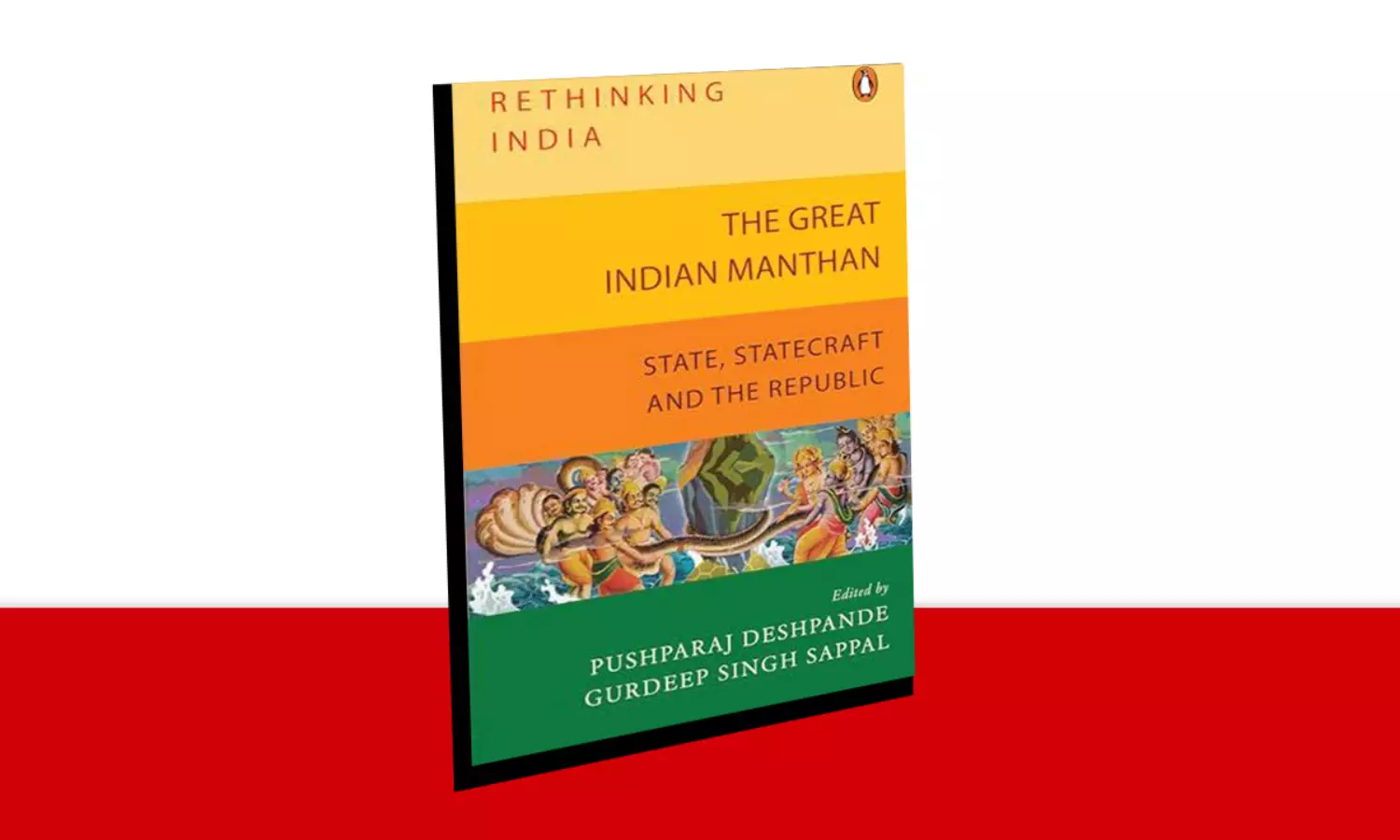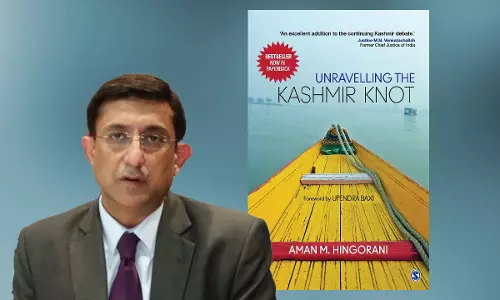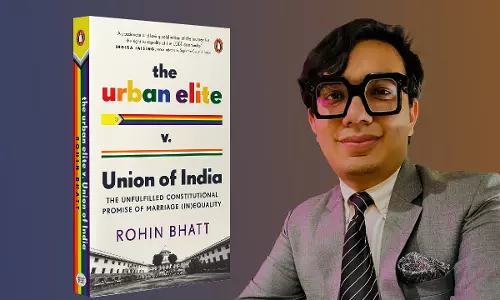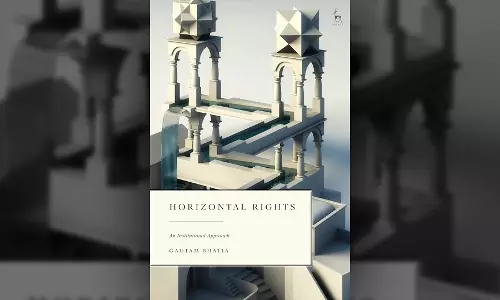
“It was the best of times, it was the worst of times, it was the age of wisdom, it was the age of foolishness, it was the epoch of belief, it was the epoch of incredulity, it was the season of light, it was the season of darkness, it was the spring of hope, it was the winter of despair.” ...
“It was the best of times, it was the worst of times, it was the age of wisdom, it was the age of foolishness, it was the epoch of belief, it was the epoch of incredulity, it was the season of light, it was the season of darkness, it was the spring of hope, it was the winter of despair.”
- Charles Dickens, A Tale of Two Cities.
I kept pondering over the above lines unconsciously when I closed a critical yet reflective tome on the state of State of India i.e Bharat titled, The Great Indian Manthan edited by Pushparaj Deshpande and Gurdeep Singh Sappal under the Rethinking India series. The book begins with a brilliant introduction by Pushparaj Deshpande, about which I shall talk in the later part of this article. Chapter first by Mallikarjun Kharge throws light on the modus-vivendi of the Cabinet system of India. It begins with the historical antecedents, throwing light on the qualitative adoption of parliamentary democracy by the Constituent Assembly. In the initial paragraphs the intellectual fodder and difference this book offers is when one reads about India's adoption of 'daily assessment of responsibility' than America's 'periodic assessment of responsibility'. This marks the wisdom which Ambedkar has illustrated in his speeches by adopting qualitative principles, delving into Aristotelian method of comparative constitutionalism and arriving at the golden mean of the unique yet indianised cabinet system - idea of Bagehotian buckle of cabinet. Kharge delves deep into the post-independence history using both traditional as well as modern frameworks of comparative politics analysing politics as science accomodating even today's post-truth and post-state state times. He ends his essay by reminding the Nehruvian call to preserve plurality and multicultural underpinnings that shall ensure continuation of the true spirit of India's civilisation rather than laying brains and commonsense at the feet of the messiah. What I loved about the essays in these book is not just their content but meticulous references that are deployed by all authors. Kharge uses Alexandrowicz, Sisson, Barbieri and others that makes his essay terse, analytical and supported by facts (rare in today's times).
Chapter two by Sonia Gandhi gives a transparent overview of National Advisory Council (NAC). The generally constructed and popularised discourse about NAC was of its undemocratic nature and tendency to bypass formal constitutional mechanisms. But, in recent times with much PMOisation of executive and legistative powers it seems difficult to trust those discourses today. The essay lays down the constructive work of NAC, its effecting positive changes in the functioning of the then government by striking a majjamika between growth and development, and lastly an overview of how the currrent dispensation is undoing and abusing those very socio-democratic initiatives like RTI, FRA, MGNREGA and others - less allocation of funds, delayed payments, assaulting and punishing federal states not ready to cow down by deep state. The essay is a crtique of current governmentality, its grafting of its ideological hegemony over the fundamentals of the social contract enshrined in the preamble.
Chapter three and four respectively by Hamid Ansari and Sitaram Yechury follow the trend of this series to put forth a panoramic account of Parliament and Coalition politics. Meticulously backed by references, Ansari warns of elective despotism that is based on the tyranny of majoritarian hegemony. Going through the events in recent times that have hampered the dignity of Parliament, he points to the erosion of etiquettes of the parliamentarians. His essay pointing towards loopholes offers corrective mechanisms to plug them within the constitutional framework. Yechury offers his insights to make coalition politics work by delineating the principles on which coalitions should be based in the first instance. These very principles for him could be learnt, incorporated via historical Indian experience of coalitions as means towards an egalitarian Idea of India. His brief description of the Mandal-Kamandal politics is interesting but as a reader, I felt it had to be described in more detail for the Millenial and Gen Z students, who are literate yet uneducated and succumb to the idea, ideology and performances of Nietzsche's Superman.
Chapter five on India's Judiciary by Madan Lokur is a must read to understand the trajectory of Judiciary of India and look at its functioning from a constructive critical framework. In the current times where law is deliberately used as a means to punish than instititionalise Justice, Lokur paints hope where justice and law shall be synchronous. He illustrates some landmark cases that portray the judiciary maintaining its integrity in the times of chaos. What stands out in this chapter is the degradation of judiciary post 2015, where undue interference and clashes with other arms of the state led to the disbandment of the Social Justice bench of Hon. Supreme Court of India that has inherently hampered the access to justice for the marginalised. Similarly, he also highlights the Masonic secrecy that is the trait of the collegium system that derives its genesis in the inherited social, cultural privileges and the damage it has brought when it strives to appease and be on the right side of the political spectrum. This has a rampant effect on the functioning of the Judiciary, erosion of constititional ethics and trust deficit in the idea of Justice. He lastly has mooted for adoption of Banglore principles of judicial conduct which could be a initial start in running a full marathon of judicial reforms.
In the next chapter Margaret Alva has put forth the menace of politicisation of the office of Governor. Her focus is more on recent events where those appointed as Governors have shown inclination to the dogmas of ideology than the expected principles of Constitutional propriety. She reminds of the ethos of the office of the governor by highlighting the S. R. Bommai judgment, ARC reports, various reports of the commissions like Sarkaria Commission, Venkatachaliah Commission, Punchhi Commission. She bats for upholding the Federal doctrine along with careful use of discretionary powers for political motives by the Governors. She wants that the focus should be on constructive opportunities offered by the office like administration of Fifth Schedule areas. In line with the idea of upholding Federalism, Dr. T. M. Thomas Isaac's essay on fading of Federal institutions is a thick description of the erosion of institutionalized federalism and centralisation of the Union. Among the varied described institutions his take on the Finance commission and GST council (both constitutional bodies) is a timely read. He shows how Democratic institutions can be used to erase the spirit of Democracy owing to the behavior of the persons donning the institutions. This has set in a decay and has started to manifest in the rising clashes on the lines of North-South divide as the very basis lies in the Union's centralisation tendency and hegemony on the lines of Hindi, Hindu and Hindutva disregarding the historical basis of linguistic formation of federal structure and pluralistic ideals that forms the edifice of this Federal arrangement. In concluding his essay, Isaac warns the union of dictating, My way or the highway approach which is a dent to the basic structure of the Constitution itself.
Ashok Lavasa's essay on Election Commission is a portrayal of some unknown facets and instances that challenge the democratic exercise of elections. Starting with Churchill's conception of a flawed yet essential form of government, Lavasa charts the performance of India as a Democracy. He delves deep into the malaise that has ruptured the electoral process. The deployment of a unique cash-crime-surrogate publicity nexus compounded with enjoying impunity by the political parties even after flouting the moral and legal tenets is illustrated in detail. Very important read is his analysis of the Electoral bond scheme, supplementing it with forward and backward linkages that have the audacity to dismantle democracy. He gives a call for individuals, other arms of the state and civil society to avert the incoming catastrophe and restore the credibility of the Election commission. This chapter also assumes importance today in the light of the newly instituted Election Commissioners Act, 2023 which has been perceived as an assault on the ideal of Constitutional Morality. Atlast, he ends with words of wisdom by Rajendra Prasad to elect the people with integrity, character, honesty to ensure the Constitution as an effective tool for the welfare of the country.
Wajahat Habibullah and Dr. Naresh Chandra Saxena have essayed their thoughts on Right to Information and Bureaucracy respectively. Habibullah has started his essay with Kofi Annan's call for transparency as an agency for achieving effective democracy. He talks about the historic struggle by civil society in instituting the Right to Information Act which was heralded as 'the fall of the Bastille'. Also, the way in which the act was mutated administratively, legally and politically is documented in a poignant manner that has undermined the foundation of democracy in India. Taking refuge in Justice Brandeis' words, he asks for perseverance to reclaim power by vigorous persuasion of transparency in all aspects of government to make it truly Democratic. Dr. Naresh Chandra's essay assumes importance when looked from the historical perspective. The rise of Totalitarian regimes have been accompanied by their very steel frames which Hannah Arendt has shown in her classic texts namely, On the Origins of Totalitarianism and Eichmann of Jerusalem. In the Neo-liberal times with receding State, rising privatisation, lateral enteries and power being exercised by Elites and Corporates, the much celebrated steel frame assumes importance. Highlighting the maenace of committed and politicised bureaucracy along with the compounding of earlier rot like corruption, favouritism and the upright officials facing institutionalised vindictiveness from political executives, the essay still places its faith in bureaucracy and its transformational and visionary capacities.
Beginning with greek political thought with the likes of Cicero, the concept of civil society assumed varied meanings. Adam Ferguson developed the concept of civil society in terms of morality and insulating it from State. On for Tocqueville, civil society was a network of non-political social organizations essential for Democracratic functioning. Prof. Ingrid Srinath's chapter on civil society puts light on dialectics between the concepts of civil society and state and market. In India's peculiar case Srinath argues for the instrumentality of civil society to institute Real Democracy. Srinath's emphasis is on 'freedom from', which faces more assault than 'freedom to' in todays times and moots for practise of Democracy by taking cue from Universal principles. Finally she gives a blueprint of 'ought to be' framework that should form the basis for well functioning of civil society in light of Gandhian ethos to travel from Antyodaya to Sarvodaya. The last chapter by Gurdeep Singh Sappal is an teleological extension of all the chapters by putting forth deliberative solutions to reclaim and repurpose the state, striving till the pledges that we as a nation took during its foundation and we as a nation take everyday in the light of our organic Constitutional zeitgeist.
I am deliberately discussing the introductory essay by Pushparaj Deshpande during the concluding part of my writeup. Deshpande's essay is a cathartic experience to read for the students of democracy. Rich with truism of references, factual truths and opinions its strives for a a call for reclaiming and restoring the ideals that the founders strived for in making of substantive democracy in context of India. He laconically touches upon social, economical, political, cultural and other metanarratives that constitute the animate principles of democracy. The most impressive part for me within his essay (must confess to have read and reread it aloud with my dear friends- passionately debated, discussed with them) about the concept of patriotism. His reminder for insufficient investment in political cultivation of emotions, Rousseau's civil religion, amnesia about Ambedkar's maitree as the basis for democracy, dilineating the intellectual yet organic idea of Maanavnishtha Bharatiyata is brillinatly foregrounded. This chapter is an inspiring read which introduces a reader to the overall daring schema of this book.
To conclude, this book is a fantasmatic (for We, the people) yet deliberate as well as daring initiative in these times of religious hysteria and compounding melancholy when Constitutional ideals are stuck between Scylla and Charybdis. This text is jiva and to borrow from Shamanic tradition, they are living and moving forces for building maneuver warfare in these times of distress in the hope of reclaiming and asserting Maanavnishtha Bharatiyata.
The author is a Senior Research Scholar at IIT-DELHI.




